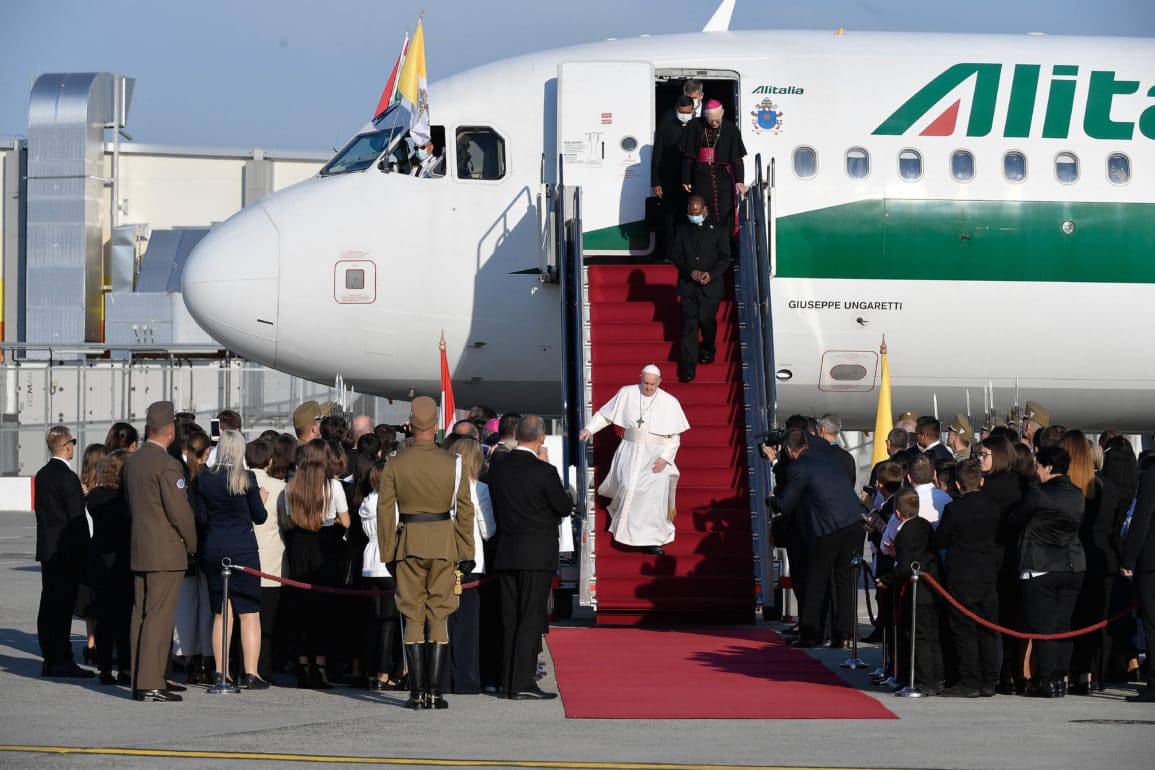Pope Francis is already in Budapest, Hungary, to close the 52nd International Eucharistic Congress. This is the first stop on his 34th international apostolic journey, which also includes Slovakia and whose motto is “With Mary and Joseph on the way to Jesus”.
At the press conference on the plane back from his trip to Iraq, last March, the Holy Father expressed his intention to go to this city. “Now I will have to go to Hungary for the final Mass of the International Eucharistic Congress, not a visit to the country, but only for Mass.” He added: “But Budapest is a two-hour drive from Bratislava, why not pay a visit to Slovakia? This is how things turn out… ”. Francis confirmed his trip at the Angelus on July 4: “From September 12 to 15, God willing, I will travel to Slovakia for a pastoral visit (…). Before [Sunday morning, September 12] I will concelebrate in Budapest the closing Mass of the International Eucharistic Congress ”.
The Pope was received by the country’s Deputy Prime Minister, Zsolt Semjén, at the foot of the plane’s steps, the Pontiff greeted the people gathered, including children. Immediately afterward, His Holiness and Semjén headed to their respective cars.
Budapest
The capital and largest city of Hungary (1,774,000 inhabitants), known as the “Pearl of the Danube”, is located in the north-central part of the country, on the banks of the Danube River, which runs through the capital. The modern city limits were drawn in 1873 with the unification of the cities of Buda and Óbuda on the west bank and Pest on the plain on the east bank.
Besides being the seat of government, Budapest has always been an important European city, a political, cultural, and industrial center, as well as a transportation hub and a popular tourist destination.
The union between Austria and Hungary took place in 1867. Under the Habsburgs, the city flourished and numerous churches and public buildings were built. In 1873, with the definitive unification of Óbuda, Buda, and Pest, Budapest was, after Vienna, the most important city of the Austro-Hungarian Empire.
At the end of World War I, with the Treaty of Saint-Germain-en-Laye, Austria recognized the independence of Hungary and, after World War II, Budapest became the capital of a Hungarian satellite state of the Soviet Union.
In 1956, the city rose up against Soviet rule, but the revolutionary movement was violently suppressed by the Red Army troops. Between 1956 and 1988, under the government of János Kádár, a semi-liberal communism known as “goulash communism” prevailed and the liberalization of the Hungarian economy began. Communism collapsed in 1989, and the country became a member of the European Union in 2004.
Main monuments of the city: the hill of the Buda Castle, where the Royal Palace is located, included in the UNESCO World Heritage list since 1987; the National Gallery; the Church of Matías (13th century); the Fisherman’s Bastion, the city’s fortress, which offers a panoramic view of the Danube and the Pest district; and, in the historic Óbuda, the remains of the old Aquincum and its baths.
Archdiocese of Esztergom- Budapest
It dates from the 10th century and on May 31, 1993, the name of Budapest was added. It has an area of 1,543 km and 2,060,130 inhabitants, of which 1,238. 300 are Catholic.
The archdiocese has 158 parishes; 26 churches; 240 diocesan priests (1 ordained last year); 144 regular priests residing in the diocese (2 ordained last year); 33 permanent deacons; 37 seminarians in the philosophical and theological courses; 184 men and 319 women religious; 73 educational institutions; 31 charities. Last year 5,550 baptisms were celebrated in this ecclesiastical circumscription.
Archbishop of Esztergom- Budapest
The Metropolitan Archbishop of Esztergom-Budapest is Cardinal Péter Erdő. Born in Budapest on June 25, 1952, he was ordained a priest on June 18, 1975.
He was elected titular bishop of Puppi on November 5, 1999. Consecrated on January 6, 2000, he was promoted to Esztergom-Budapest on December 7, 2002. On October 21, 2003, Saint John Paul II created him a cardinal, with the title of Santa Balbina.










